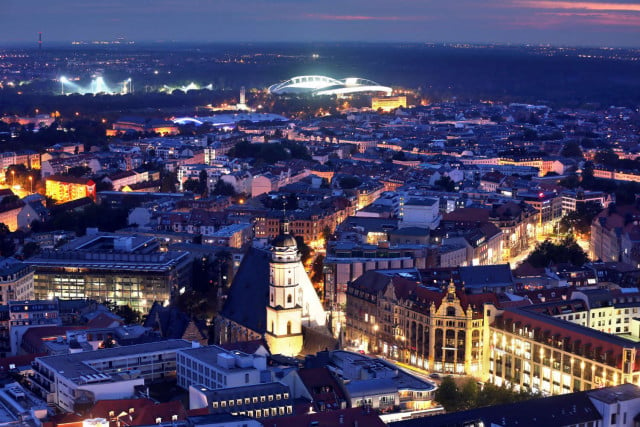'The wounds still hurt today' despite progress: 28 years of German unity

The former communist east Germany has made major progress but is still lagging behind the west nearly three decades after reunification, according to a new study.
In the annual report on unity, which was officially presented on Wednesday by the German government, the report authors state that living conditions in the east of Germany have come closer to those in western states over the past 28 years.
However, eastern Germany is still behind in terms of wage levels and economic strength, reports DPA. There is also a lack of corporate headquarters for large companies in the east, and the economy, although it has improved, is still less export-oriented.
The study was published ahead of ‘Tag der Deutschen Einheit’ - German Unity Day - which is a national holiday throughout the country and takes place on October 3rd to celebrate east and west Germany’s official reunion in 1990.
'Wounds still hurt today'
The report authors said the road to unity was lined with "both success and setbacks".
They wrote: "We are proud of the strength with which the people of the east in particular have mastered the fundamental changes" and added that they were "grateful for their courage and perseverance".
However they acknowledged that German unity "does not satisfy all citizens" despite the "impressive successes achieved".
They said that particularly in eastern Germany "the wounds still hurt today, which were not only caused by the dictatorship, but also by the economic and social upheaval in the former GDR (German Democratic Republic)."
 Christian Hirte on Wednesday with the government report on unity. Photo: DPA
Christian Hirte on Wednesday with the government report on unity. Photo: DPA
Christian Hirte (CDU), the government's commissioner for the five former communist states, said that differences highlighted in the report were still evident in everyday eastern German life.
"Despite all the successes, we still see a high degree of dissatisfaction and skepticism," he said.
"We must take this seriously. The Federal Government must create opportunities in the east, particularly given attitudes towards the establishment and public authorities, or the structural changes we're seeing in coal mining areas."
Gap is closing - slowly
The positive development of the east German economy continued in 2017. Gross domestic product (GDP) rose by 1.9 percent (compared to 2.3 percent in western Germany) and the unemployment rate fell to 7.1 percent in December last year, compared with 8.7 per cent in the previous year, the study says.
Last year, the overall GDP per inhabitant in the east was 73.2 percent of that in the west, largely unchanged from the previous year.
Over the past 10 years, the difference between eastern and western Germany has narrowed by 4.2 percentage points.
"The trend is therefore clear," states the report. "The gap between east and west is narrowing further, but east Germany's economic power is approaching west Germany only very slowly."
'Young people leaving'
At the beginning of the 1990s there was a mass exodus of east German citizens leaving, particularly young, well-qualified people. According to the report, this had long term consequences.
The Berlin Wall, which fell in a peaceful revolution on November 9th,1989, ended four decades of post-war division and paved the way to reunification 11 months later.
Analysts have previously said that the fall of the wall sparked this major emigration movement, but this has slowed in recent years.
 A weathered GDR border post on the site of the border monument in Hötensleben, Saxony Anhalt, on the former east German border. Photo: DPA
A weathered GDR border post on the site of the border monument in Hötensleben, Saxony Anhalt, on the former east German border. Photo: DPA
Despite an increase in the birth rate, the population continues to decline, especially the number of people who are able to work. It means ageing is progressing faster in the east than in the west German states.
"This affects the balance of economic strength and living conditions in many ways,” the report states. The government says it intends to continue its efforts to reduce existing structural weaknesses in the east.
Currently 59 percent of the eastern states' population is of working age (between 20 and 64) while a quarter are old enough to retire (65 years and older).
By 2030, the economy ministry estimates that only 52 percent of the population will be working and 32 percent will have retired.
While western Germany is experiencing similar demographic patterns, the process is less noticeable.
The less favourable age structure compared with western Germany and the lower settlement density in many eastern German regions is already limiting the number of skilled workers.

Eastern German city Leipzig. Photo: DPA
"In about two thirds of all occupations, the situation has deteriorated further over the past five years; this is particularly true in eastern Germany,” says the report.
Rural communities at a disadvantage
The report also highlighted rural communities in the east. It said living conditions were increasingly unequal between "prospering regions” such as Berlin, Leipzig, Dresden and Erfurt and weak areas of emigration such as in rural landscapes.
However, there has been major progress in east Germany’s journey since reunification, like the labour market developing positively.
According to the report, the unemployment rate in the east was more than 10 percentage points lower than in the west at the beginning of the 2000s, and only 2.3 percentage points lower in 2017.
It is also said that eastern Germany is particularly strong in research into key technologies.
In the former east, roles of men and women were considered equal, meaning both sexes tended to work.
This is reflected in the study, with women accounting for just under 50 percent of all workers. Balancing professional and family life appears to be easier in the east than in the west, according to the report.
But there were still wage differences, and average incomes were lower than in west Germany.
Hate crimes
Although the number of right wing hate crimes fell throughout Germany from 1,600 in 2016 to 1,054 in 2017, more than 50% of the right-wing extremist acts happened in eastern Germany.
A total of 572 offences took place in east German states last year and 774 in 2016, according to the figures.
Eastern Germany has a strong connection to far-right activities, although they involve a minority of citizens. There have been far-right protests recently in the eastern German city of Chemnitz, sparked by the death of a German man, allegedly by asylum seekers. Dresden, also in the east, is where the far-right anti-Islam Pegida movement was launched.
The Federal Government's strategy for the Prevention of Extremism and the Promotion of Democracy aims to go "nationwide" into schools, districts, associations and other social areas in a bid to crack down on extremism.
Comments (1)
See Also
In the annual report on unity, which was officially presented on Wednesday by the German government, the report authors state that living conditions in the east of Germany have come closer to those in western states over the past 28 years.
However, eastern Germany is still behind in terms of wage levels and economic strength, reports DPA. There is also a lack of corporate headquarters for large companies in the east, and the economy, although it has improved, is still less export-oriented.
The study was published ahead of ‘Tag der Deutschen Einheit’ - German Unity Day - which is a national holiday throughout the country and takes place on October 3rd to celebrate east and west Germany’s official reunion in 1990.
'Wounds still hurt today'
The report authors said the road to unity was lined with "both success and setbacks".
They wrote: "We are proud of the strength with which the people of the east in particular have mastered the fundamental changes" and added that they were "grateful for their courage and perseverance".
However they acknowledged that German unity "does not satisfy all citizens" despite the "impressive successes achieved".
They said that particularly in eastern Germany "the wounds still hurt today, which were not only caused by the dictatorship, but also by the economic and social upheaval in the former GDR (German Democratic Republic)."
 Christian Hirte on Wednesday with the government report on unity. Photo: DPA
Christian Hirte on Wednesday with the government report on unity. Photo: DPA
Christian Hirte (CDU), the government's commissioner for the five former communist states, said that differences highlighted in the report were still evident in everyday eastern German life.
"Despite all the successes, we still see a high degree of dissatisfaction and skepticism," he said.
"We must take this seriously. The Federal Government must create opportunities in the east, particularly given attitudes towards the establishment and public authorities, or the structural changes we're seeing in coal mining areas."
Gap is closing - slowly
'Young people leaving'
At the beginning of the 1990s there was a mass exodus of east German citizens leaving, particularly young, well-qualified people. According to the report, this had long term consequences.
The Berlin Wall, which fell in a peaceful revolution on November 9th,1989, ended four decades of post-war division and paved the way to reunification 11 months later.
Analysts have previously said that the fall of the wall sparked this major emigration movement, but this has slowed in recent years.
 A weathered GDR border post on the site of the border monument in Hötensleben, Saxony Anhalt, on the former east German border. Photo: DPA
A weathered GDR border post on the site of the border monument in Hötensleben, Saxony Anhalt, on the former east German border. Photo: DPA
Despite an increase in the birth rate, the population continues to decline, especially the number of people who are able to work. It means ageing is progressing faster in the east than in the west German states.
"This affects the balance of economic strength and living conditions in many ways,” the report states. The government says it intends to continue its efforts to reduce existing structural weaknesses in the east.
Currently 59 percent of the eastern states' population is of working age (between 20 and 64) while a quarter are old enough to retire (65 years and older).
By 2030, the economy ministry estimates that only 52 percent of the population will be working and 32 percent will have retired.
While western Germany is experiencing similar demographic patterns, the process is less noticeable.
The less favourable age structure compared with western Germany and the lower settlement density in many eastern German regions is already limiting the number of skilled workers.

Eastern German city Leipzig. Photo: DPA
"In about two thirds of all occupations, the situation has deteriorated further over the past five years; this is particularly true in eastern Germany,” says the report.
Rural communities at a disadvantage
The report also highlighted rural communities in the east. It said living conditions were increasingly unequal between "prospering regions” such as Berlin, Leipzig, Dresden and Erfurt and weak areas of emigration such as in rural landscapes.
However, there has been major progress in east Germany’s journey since reunification, like the labour market developing positively.
According to the report, the unemployment rate in the east was more than 10 percentage points lower than in the west at the beginning of the 2000s, and only 2.3 percentage points lower in 2017.
It is also said that eastern Germany is particularly strong in research into key technologies.
In the former east, roles of men and women were considered equal, meaning both sexes tended to work.
This is reflected in the study, with women accounting for just under 50 percent of all workers. Balancing professional and family life appears to be easier in the east than in the west, according to the report.
But there were still wage differences, and average incomes were lower than in west Germany.
Hate crimes
Although the number of right wing hate crimes fell throughout Germany from 1,600 in 2016 to 1,054 in 2017, more than 50% of the right-wing extremist acts happened in eastern Germany.
A total of 572 offences took place in east German states last year and 774 in 2016, according to the figures.
Eastern Germany has a strong connection to far-right activities, although they involve a minority of citizens. There have been far-right protests recently in the eastern German city of Chemnitz, sparked by the death of a German man, allegedly by asylum seekers. Dresden, also in the east, is where the far-right anti-Islam Pegida movement was launched.
The Federal Government's strategy for the Prevention of Extremism and the Promotion of Democracy aims to go "nationwide" into schools, districts, associations and other social areas in a bid to crack down on extremism.
Join the conversation in our comments section below. Share your own views and experience and if you have a question or suggestion for our journalists then email us at [email protected].
Please keep comments civil, constructive and on topic – and make sure to read our terms of use before getting involved.
Please log in here to leave a comment.